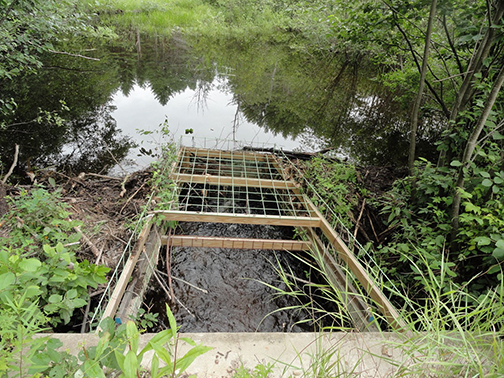
Skip Lisle, President of Beaver Deceivers International, was recently in town to check on two Beaver Deceiver installations, one on Elbow Pond Road and one on Valley Road. There was concern about debris and beaver damming against the fencing as well as whether the pipes were blocked by debris.
The structures at Elbow Pond Road are in excellent condition. The beavers had clearly been active and had dammed up the sides of one structure. The pipes that pass through the fencing remain clear and continue to allow water to pass through. This prevents damming inside the culvert, and the road remains safe from flooding.
Skip explained that debris and damming along the fencing is expected and does not need to be cleared off. As long as water is running freely through the pipes, the system is doing its job.
At Valley Road, the concern is the amount of sand and sediment that has washed into the area and up against the pipe system. When Skip checked the pipe, it was completely clear of sediment. The fence had some debris that had washed up against it, which he cleared away. There is a lot of sediment washed up alongside the pipe that goes through the fencing, although there is a clear channel on the other side of the pipe.
Because of the amount of sediment in that area, anything that is placed in the stream will cause changes in how the stream flows. In that sense, we don’t have a perfect solution. In terms of protecting the bridge and the road, the installation has been successful.
I have been told that concerned residents on Valley Road have often cleared debris or sediment out of the area. It would be helpful to contact me (Vicky Mishcon at 735-6402) so that I can take photos and pass them on to Skip so that he can see any problems before they get cleared away.
Beaver Deceivers in Andover
For readers who are unfamiliar with beaver deceivers, a short history of their use in Andover follows:
Since 2007, Andover has had eight beaver deceivers installed throughout our town. Skip Lisle
was contacted 13 years ago to solve an ongoing flooding issue on Elbow Pond Road. The primary purpose of a Beaver Deceiver is to prevent the beavers from building a dam inside a culvert or under a bridge. Skip’s solution is unique in that the device prevents damming in the culvert, without killing the active beaver in the area.
A typical Beaver Deceiver is a trapezoidal fence that is narrow at the culvert and widens upstream. Shapes and sizes and overall design vary according to the site. The fence is made with cedar or pressure treated wood posts and concrete reinforced steel sheet fencing. The fencing and pipes allow water, fish, turtles, frogs, and other aquatic animals to pass through.
The fence structure is combined with polyethylene pipe which extends from the fence structure at the culvert upstream to a second structure which covers the end of the pipe to prevent damming. The pipe keeps the water flowing even if the beavers attempt to dam the fence. The level of the pipe can be adjusted to the desired water level on the upstream side of the culvert.
The cost for a new installation is about $3,000 depending on the site. For the past several years, the town has had a line item in the highway budget of $1,500 to $5,000 for Beaver Deceivers, which covers a new installation or any maintenance or design improvement needed.
Very little maintenance is actually necessary, due to the quality of the materials and workmanship. Many people think that sticks and debris that wash up against the fence have to be cleared regularly, but the device works with or without debris, as long as the pipes remain clear.